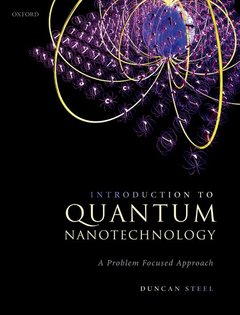Description
Introduction to Quantum Nanotechnology
A Problem Focused Approach
Author: Steel Duncan G.
Language: English
Introduction to Quantum Nanotechnology
Publication date: 04-2021
400 p. · 19.6x25.4 cm · Hardback
Publication date: 04-2021
400 p. · 19.6x25.4 cm · Hardback
Introduction to Quantum Nanotechnology
Publication date: 04-2021
400 p. · 19.1x24.7 cm · Paperback
Publication date: 04-2021
400 p. · 19.1x24.7 cm · Paperback
Description
/li>Biography
/li>
Quantum is rapidly emerging as a game-changer in technology. The end of Moore's Law for exponential growth is rapidly approaching and engineers and physicist alike are looking at moving past the classical limitations of modern technology and are exploring the new opportunities that quantum behaviour creates in sensing, metrology, communications and information processing. This book serves as introduction to quantum theory with emphasis on dynamical behaviour and applications of quantum mechanics, with minimal discussion of formalism. The goal is to help students begin to learn the tools for a quantum toolbox they will need to work in this area. It is aimed at upper level undergraduates and first year graduate students and assumes the reader has not had any training in quantum mechanics beyond what might be encountered in two semesters of introductory physics. The language of quantum is mathematics and builds on what is covered in typically the first two years. The first six chapters introduce Schrödinger's equation and develop the quantized description of common systems that exist in real space like a vibrator, nano-particles, atoms, crystals, etc. Beginning in Ch. 7 and for the remaining nine chapters, the focus is primarily on dynamical behaviour and how to think about real quantum systems. Spin, the quantized electromagnetic field, dissipation, loss and spontaneous emission, are discussed as well as quantum optics and the operator equations for common two-state systems such as the quantum flip flop and the density matrix equations. The book is structured so that a two semester course sequence is possible or a single semester course with options discussed in the preface to set different learning objectives. Even a one semester course based on this text covers much more material than a typical upper quantum course for undergraduates in physics, but at the expense of more detailed discussions about solutions to various differential equations such as for angular momentum and the hydrogen atom or band theory for semiconductors.
Duncan G. Steel, The Robert J. Hiller Professor, Professor of Electrical Engineering and Computer Science, Professor of Physics, The University of Michigan - Ann Arbor. PhD in 1976 in Electrical and Nuclear Science, University of Michigan. Guggenheim Fellow (1999), APS Isakson Prize (2010), Elected Fellow of APS, OSA, and IEEE. 10 years at Hughes Research Laboratories (senior staff physicist), faculty at the University of Michigan (1985-), Area Chair for Optics and Director of the Optical Sciences Laboratory 1988-2007, Director of Biophysics 2007-2009.
© 2024 LAVOISIER S.A.S.
These books may interest you

Laser Physics 160.25 €



